Remarks by Tim Johnson, Woodland Cultural Centre, October 29, 2012
On behalf of the Smithsonian Institution's National Museum of the American Indian I extend congratu1ations to Executive Director Janis Monture, to her staff, and to the Woodland Cultural Centre Board of Directors on the development and installation of this timely, relevant and very important exhibit, "War Clubs & Wampum Belts: Haudenosaunee Experiences Of The War Of 1812."
I also want to recognize and honor the work of Curator Rick Hill. I've known and worked with Rick for over 30 years and never cease to be amazed by his relentless commitment to education, to Cultural preservation, and to the public interest. Rick is a master teacher who helps us all better Understand how past events have shaped the complex realities of our contemporary lives.
The War of 1812 was a defining period for Six Nations and other Native Nations that became involved in the conflict. For Six Nations, as but one example, the war's outcome served to stem the uncertainty of two centuries of upheaval and relentless violence. For Canada, the unfinished business of the American Revolution finally yielded to peace and the firm establishment of secure borders within which their fledgling country could take root. Canada's identity emerged during this time. In numerous battles defending against invading American forces an esprit de corps emerged from the accumulated victories. But let us never forget that many critical engagements in the War of 1812 included the participation and sacrifice of Native peoples - on both sides of the disputed border.
In the Canadian context, the participation of Six Nations leadership and forces, as well as that of numerous other First Nations, were crucial to the successful repulsion of invading American forces. One could make a strong circumstantial case that Canada would be very different today were it not for the involvement of Native peoples. And yet, who, within our own communities, and, more broadly, within educational systems across Canada, fully comprehends this history? The need to educate not just our own students at Six Nations, but all Canadians, about this pivotal event in history is why this exhibit is so important. Every student needs to learn about the role that First Nations peoples played in the War of 1812. And they all need to see this exhibit.
Native students rarely see themselves in the educational content they study and consume in school. The general absence of information about Native peoples in educational curricula has been a lingering oversight extending back hundreds of years. This does little to provide context and relevance, not to mention inspiration, for Native students who, by and large, do not see themselves in their own histories. On the other hand, non-Native students are also deprived a well-rounded and complete educational experience when they are NOT taught about the contributions Indigenous peoples have made to the foundation and character of Canada, the United States, and other countries within the Western Hemisphere.
The National Museum of the American Indian recognizes the importance of educating the public about the War of 1812. During the past two years we have been actively involved in several initiatives that have contributed to this objective.
First we assisted in the development of a public art process and the crafting of a request for proposals to establish a public artwork in Queenston Heights Park that will recognize and honor Six Nations and Native ally contributions in the Battle of Queenston Heights and the War of 1812, As the result of this work an inspirational site plan and artistic collaboration have been achieved.
Second, in partnership with the twenty-first Prime Minister of Canada, the Right Honourable Paul Martin, and his organization the Martin Aboriginal Education Initiative, along with Western University and Academica Group, we organized and held an Indigenous Education Summit in Niagara-On-The-Lake on October 4th and 5th. One of the themes of this conference, at which Rick Hill gave a brilliant presentation, was Indigenizing Education.
The Summit was carried out in a spirit of reflection, renewal, and relationship building. The bicentenary of the War of 1812 served as a powerful and timely symbol of the need for all Canadians to better understand the place, culture and traditions of Indigenous peoples in the history, present, and future of Canada.
Third, in April of this year, I was privileged to co-sign the release papers returning possession and custody of the William Claus Wampum Belt from the Smithsonian Institution to the Six Nations. How appropriate it was that this repatriation occurred during the bicentenary of the War of 1812, in many ways the story of this wampum belt's troubled journey is symbolic of the complicated history of relations that have existed between two former allies ever since they jointly succeeded in repelling invading American forces two centuries ago.
Finally, on display in this exhibit you will see a wool bunting Union Jack - a British flag - said to have been given to Tecumseh when the British made him a Brigadier General around 1812. Yellow Hawk, Shawnee, carried this 200-year-old flag, which is on loan from the National Museum of the American Indian, during the Battle of the Thames. As with the William Claus wampum belt it is remarkable to be in the presence of objects with such powerful historical pedigrees. These objects help us to better understand that real, three dimensional, sentient human beings, Indigenous peoples, were active players who shaped the history that we now study through this exhibit.
Congratulations again to everyone who contributed to making this exhibit a reality. We are still determining our own history, and that's a very good thing.
"Woodland Cultural Centre War Clubs & Wampum Belts Remarks by Tim Johnson"
Description
- Creator
- Johnson, Tim, Author
- Media Type
- Text
- Item Type
- Documents
- Date of Publication
- 29 Oct 2012
- Subject(s)
- Personal Name(s)
- Johnson, Tim ; Hill, Rick ; Monture, Janis ; Martin, Paul.
- Corporate Name(s)
- Woodland Cultural Centre ; Indigenous Education Summit ; Prime Minister of Canada ; Queenston Heights Park ; Smithsonian Institution.
- Local identifier
- SNPL004201v00d
- Language of Item
- English
- Creative Commons licence
 [more details]
[more details]- Copyright Statement
- Public domain: Copyright has expired according to Canadian law. No restrictions on use.
- Copyright Date
- 2012
- Contact
- Six Nations Public LibraryEmail:info@snpl.ca
Website:
Agency street/mail address:1679 Chiefswood Rd
PO Box 149
Ohsweken, ON N0A 1M0
519-445-2954 - Full Text



